Forensic medicine examination of dead bodies is one of the most important tasks in the activities of the center and is carried out at the Thanatological Section, which includes as well regional forensic medical departments situated in all the major cities of the country.
Starting from the year of 1966 a systemized processing of sectional material is done at the Thanatological section of SCFME. During occupation of Latvia till the restoration of independence in 1990 statistical processing was carried out by means of punch cards. But starting from the year of 1976 the job was done with the help of computer of the Calculating Center of the Latvian Ministry of Health Care. For this purpose were created a special algorithm and a mathematical program. At present the entire processing job is done with the help of a PC, using special software.
We made a research on statistical information for the cases of violent death during the period of 1966-2000. (35 years).
The caring out of forensic-medicine expertise with the reference to violent death is one of the most important and time-consuming sections of work and makes up 67% of the total autopsied bodies.
A violent death refers to all kinds of injuries of a human body from external impact.
Judging by the graphics of allocation of the researched corpses on a kind of death (graph 1) there is a tendency of gradual, undulating grows of cases both violent and unviolent deaths, and total number of researched bodies.
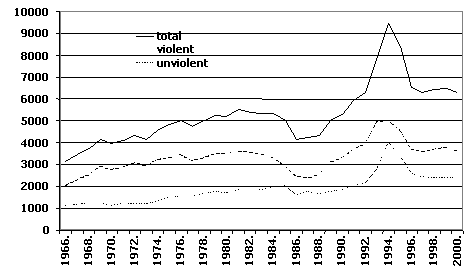
Graph 1
Thus their sharp increase as peak in 1991-1996 is seen during a change of political and economical situation in the country. Dividing this graph into equal time periods, you can see that in relation to violent deaths in 1966, by 1970 the increase was 36%, by 1975 - 63%, 1980 - 81%. A small collapse during 1981-1985 took place, but then by 1990 increased up to 63%, by 1995 - up to 125%. During the peak the number has reached 144%, then decreasing and in 2000 this number is almost equal to the level of 1980, exceeding 1966 on 77%.
Studying the reasons of death on sort (graph 2) is seen the undulating increase of cases of homicide, suicide and accidents in everyday life with a sharp peak in 1993-1995 and decrease the number of industrial traumatism.
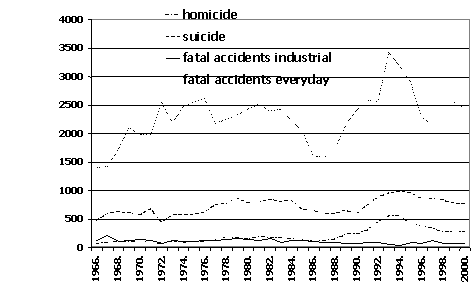
Graph 2
Now the tendency of growth of forensic-medicine expertise in the cases of homicide, the number of which in comparison to 1966, by 1970 arose on 47%, by 1975 on 56%, by 1980 by 159%, by 1985 - on 127%, by 1990 on 305%, by 1995 on 623% (the peak was in 1993 it was 825%), after that the numbers are decreasing and by 2000 exceed the level of 1966 on 374%. As to suicides, the increase happened smoothly, without sharp decreases or increases and reached it's peak in 1993 - 104.55 and by the 2000 exceeds the level of 1966 on 64%. The same tendency is traced in the cases of the accidents in everyday life: their number has reached peak in 1993 - 109.3% and by 2000. Exceeds the level of1966 on 75%. Concerning the industrial traumatism, the number, after a long stable period of time has decreased on 43%, by 1995 on 32.5%, by 2000 on 51%, what is connected to the reducing of productive capacities.
At comparative rating of sorts of violent deaths (graph 3) a tendency of undulating growth of mechanical injuries, asphyxia, poisonings and effects of extreme temperatures with the peak in 1993/1994, because of the criminal and economical situation in the country.
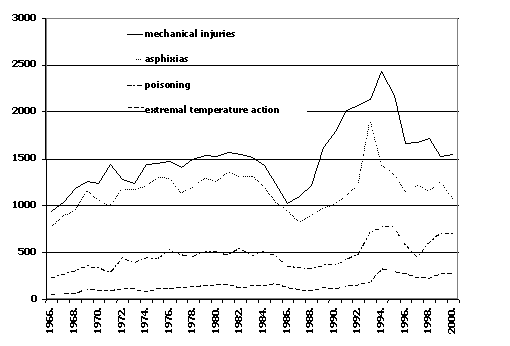
Graph 3
Mechanical injuries include dull or sharp object injury, gun shot wounds and car accidents. The variety of subjects, which surround us in everyday life, is the reason of variety of mechanical injuries.
In comparison to 1966, the numbers of mechanical injuries by 1970 increased on 37.8%, by 1975 - on 61.2%, by 1980 on 70.2%, by 1985 - on 36.8%, by 1990 - on 99.2%, by 1995 on 62.2%, in 2000 the number exceeds the level of 1966 on 64.5%.
The tendency of growth of mechanical asphyxia's corresponds the tendency of growth of mechanical injuries. The number of cases of this kind of deaths by 1995 increased on 61,8%, but in 2000 exceeds the level of 1966 on 31.1%.
In this section the number of poisonings is increasing, the biggest was in 1995?- 232,1%, but in 2000
Exceeds the level of 1966 on 189.6%.
It is also necessary to point out that for the investigated period of time the number of deaths from extreme temperatures arose. A man, using hoses and clothes can stand lowering of external temperatures for a long period of time. But at certain circumstances (bad clothes, common delicacy, ebrietas, etc.) the impact of cold entails heavy consequences - up to death. To the rise of temperature organism is a less adjusted than to lowering the temperatures. But unfortunately the high temperatures are being used for some technical and home needs, therefore the injuries from hot temperatures are frequently found in the practice of forensic-medicine expertise. As it is shown on the graph 3 by 1970 the number of death from extreme temperatures increased on 107%, by 1975 on 158.1%, by 1980 on 244.2%, by 1985 on 297.7%. There was a small decrease by 1990 - on 165.1%, and sharp increase by 1995 - on 588%, by 2000 exceeds the level 1966 on 537%. Arose the number of high and low temperatures. These are people died during the fires and cooling of body, in the wintertime. The dynamic of mechanical injuries for the studied period is mentioned above. Between the mechanical injuries (graph 4) are selected gun shot, cut/ stub wounds and injuries from dull objects, the number of which by 1995 increased accordingly on 262.2%, 223.5%, 267.8% with scale in 1994-1995. It has to be point out the increase of these kinds of mechanical traumas is connected with sharp increase of homicides. The number of car accidents increased slightly, approximately on 50%, with the peak in 1991. The high-speed cars can explain this peak, than they were before.
Between mechanical asphyxia's (graph 5), which occur because of the mechanical obstacles for the external (lung) breathing, in our practice on the first place are strangulation asphyxia's. On the second place it is the drowning in the water. It is in quantitative. However, it is necessary to point out the insignificant increase of drowning., which by 1995 was 32.4%, the numbers of strangulation with the loop increased more on 115.2%, the number of strangling by hands, loop increased sharply on 937.5%. The latest is also connected to the increased numbers of homicide.
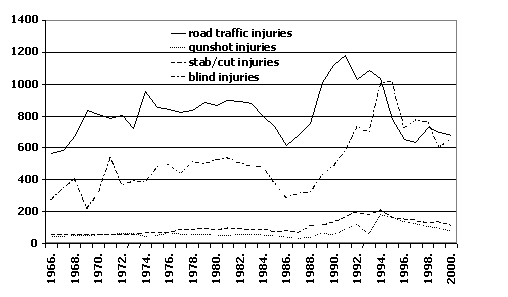
Graph 4
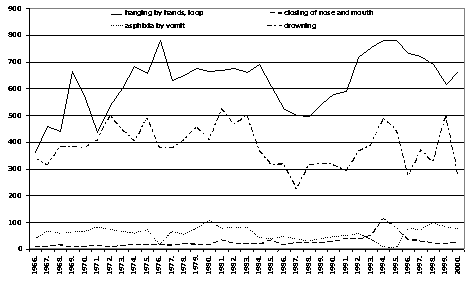
Graph 5
A graph 6 show that the significant numbers of lethal poisonings are still is cosec by the ethyl alcohol and different spirit contained liquids. On the second place there are the poisonings for the carbon gas. Poisonings from carbon gas is almost always refers to the cases of home poisonings, during the fire, sometimes?- murder. In comparison to 1966 by the 1995 the poisonings from ethanol increased on 246.3%, carbon gas on 180%, with the peak in 1993-1995.
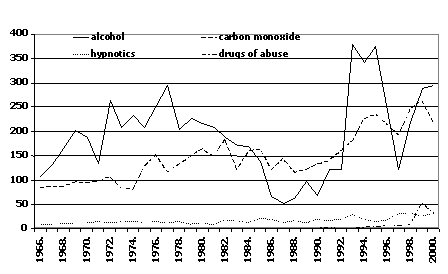
Graph 6
However the latest 8 years were characterized by poisonings from drugs (overdose).
There were the cases when the drugs were found in the organism, but the reason of death was different in the year 1991. The single cases of overdose appeared in 1991, 1999 the number was magnified by 17 times, but by 2000, the level decreased. Usually they were boys 16-20 years old.
This analysis shows that during the studied period of time there is a gradual, undulating grow of cases both violent and unviolent deaths with the sharp peak in 1991-1996 during the change of political and economical situation in the country. On this background is marked the increase of murders, impact of extreme temperatures, mechanical trauma, especially gun shot, cut/stab wounds and injuries from dull objects; between the mechanical asphyxia's - strangulation by hands, loop; appearance and distribution of poisonings from drugs, between young people. The number of industrial traumatism, decreased because of the reducing of productive capacities.
Judging by the analysis performed, one can come to the conclusion that during the whole registered period the absolute overall number of examined dead bodies has an undulating changing tendency - both increasing and decreasing. At the same time there is a steady domination of a progressive rise of all types of violent death with a sharp peak in the period from 1991 till 1996 when the political and economical fundamentals of the country were changing.
Список литературы



 Федеральное государственное бюджетное учреждение науки
Федеральное государственное бюджетное учреждение науки
